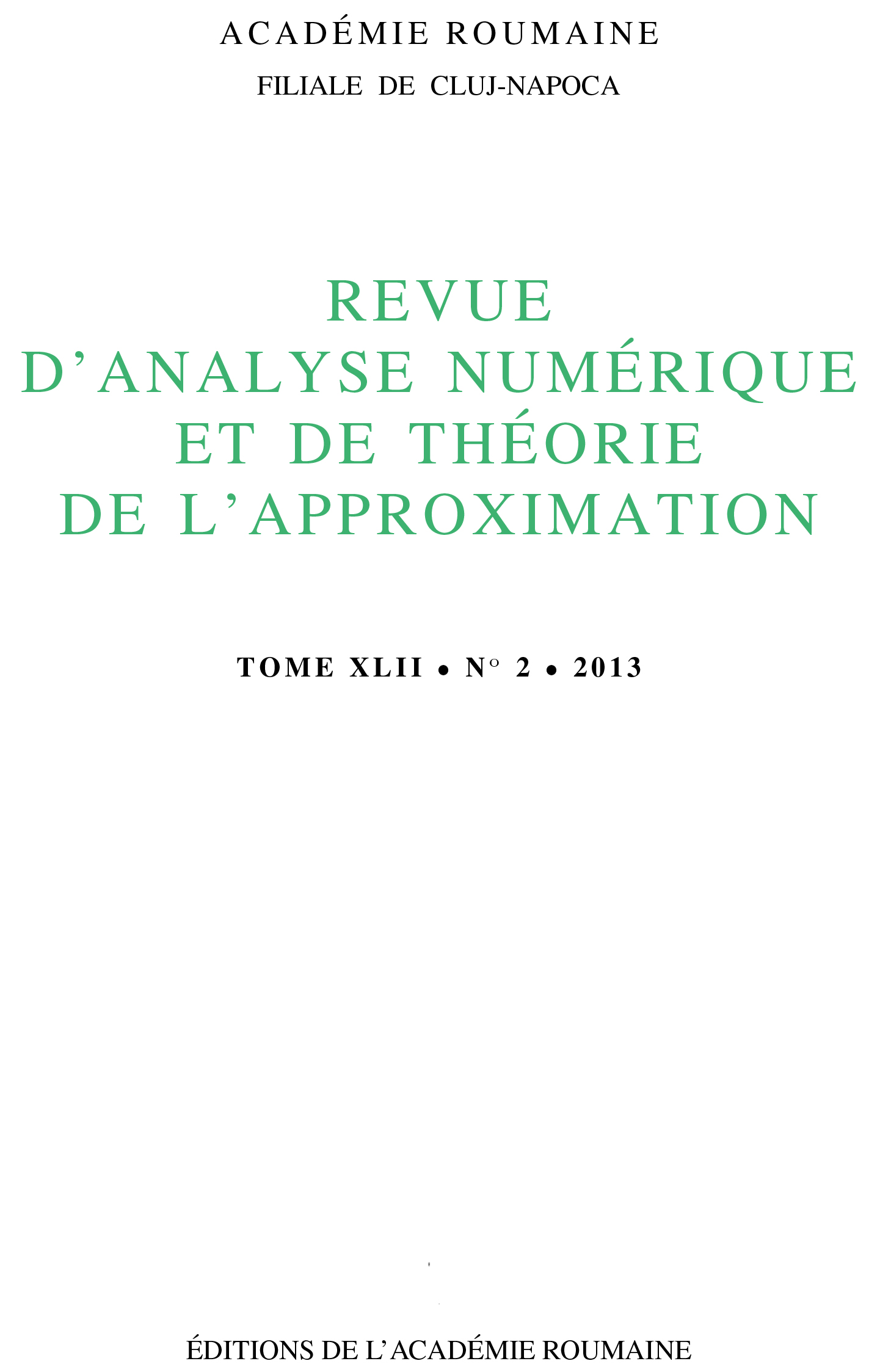On approximating the solutions of equations by the chord method and a method of Aitken-Steffensen type
DOI:
https://doi.org/10.33993/jnaat422-989Keywords:
convergence of the method of the Aitken-Steffensen typeAbstract
In [13] we have studied the existence and the convergence of iterative methods that use generalized abstract divided differences (this notion being defined there). We have indicated a construction model for these differences as well. A special place has been given to the iterative method of the chord for which we have established a convergence theorem which in the same time ensures the existence of the solution of the considered equation. We have obtained the convergence order with the value \(\tfrac{1+\sqrt{5}}{2}.\) This value is inferior to \(2,\) this last value representing the convergence order of the method of Newton-Kantorovich. This diminuation of the convergence order is the price to pay for the replacement of the Fréchet differential with the generalized abstract divided difference. In this paper we consider the issue of the improvement of the convergence order with respect to the method of Steffensen and Aitken-Steffensen or their generalizations through the method of the auxiliary sequences. This method will be presented in the paper together with the specification of the convergence order of the main sequence and the auxiliary sequences.Downloads
References
I. K. Argyros, Polynomial Operator Equation in Abstract Spaces and Applications, CRC Press Boca Raton Boston London New York Washington D.C., 1998.
M. Balázs, On the chord method for solving nonlinear operational equations, Stud. Cerc. Mat., 20 (1968) no. 2, pp. 129-136, (in Romanian).
M. Balázs, M. and G. Goldner,G. Divided differences in Banach spaces and certain applications, Stud. Cerc. Mat., 21 (1969) no. 7, pp. 985-986 (in Romanian).
M. Balázs, On applying the chord method in solving nonlinear integral equations, Stud. Cerc. Mat., 23 (1971) no. 6, pp. 841-844, (in Romanian).
M. Balázs, and G. Goldner, On existence of divided differences in linear spaces, Rev. Anal. Numér. Théor. Approx., (1973) no.2, pp. 5-9.
J. G. P. Barnes, An algorithm for solving nonlinear equations based on the secant method, Cumput. J., (1965), pp. 55-72. DOI: https://doi.org/10.1093/comjnl/8.1.66
A. Diaconu, Interpolation dans les espaces abstaits. Méthodes itératives pour la résolution des équations opérationnelles obtenues par l'interpolation inverse (I), "Babeş-Bolyai" University, Faculty of Mathematics, Research Seminaries, Seminar of Functional Analysis and Numerical Methods, Preprint, (1981) no. 4, pp. 1-52, (in French).
A. Diaconu, Interpolation dans les espaces abstaits. Méthodes itératives pour la résolution des équations opérationnelles obtenues par l'interpolalation inverse (II), "Babeş-Bolyai" University, Faculty of Mathematics, Research Seminaries, Seminar of Functional Analysis and Numerical Methods, Preprint, (1984), no. 1, pp. 41-97, (in French).
A. Diaconu, Interpolation dans les espaces abstraits. Méthodes itératives pour la résolution des équations opérationnelles obtenues par l'interpolalation inverse (III), "Babeş-Bolyai" University, Faculty of Mathematics, Research Seminaries, Seminar of Functional Analysis and Numerical Methods, Preprint, (1985), no. 1, pp. 21-71, (in french).
A. Diaconu, Remarks on interpolation in certain linear spaces (I), Researches on Numerical Methods of Analysis and Optimization, (2000) 2-1(3), pp. 3-14.
A. Diaconu, Remarks on Interpolation in Certain Linear Spaces (II), Researches on Numerical Methods of Analysis and Optimization, 2-2(4), (2000), pp. 143-161.
A. Diaconu, On the interpolation in linear spaces, Mathematica Pannonica, 14/2 (2003), pp. 205-216.
A. Diaconu, On the chord method in linear normed spaces, Topics in Mathematics, Computer Science and Philosophy, A Festschrift for Wolfgang W. Breckner, pp. 73-94.
G. Goldner and M. Balázs, On the chord method and its modification for solving nonlinear operational equations, Stud. Cerc. Mat., 20 (1968) no.7, pp. 981-990. (in Romanian).
B. Janko and M. Balázs, On the chord method for solving nonlinear operational equations in normed spaces, Stud. Cerc. Mat., 19 (1967), no. 10, pp. 1433-1436, (in Romanian).
L. V. Kantorovich, Functional Analysis and Applied mathematics (in Russian), U. M. N. III, 5, (28)(1948), pp. 29-185.
L. V. Kantorovich, Functional Analysis (in Romanian), Editura Ştiinţifică şi Enciclopedică, Bucureşti, 1986.
V. L. Makarov and V. V. Hlobistov, Osnovî teorii polinomialnogo operatornogo interpolirovania, Institut Mathematiki H.A.H. Ukrain, Kiev, (1998) (in Russian).
I. Păvăloiu, Considerations regarding the iterative methods obtained by inverse interpolation, Stud. Cerc. Mat., 23 (1971), no. 10, pp. 1545-1549, (in Romanian).
I. Păvăloiu, Interpolation dans des espaces linéaires normés et application, Mathematica (Cluj), 12, (35), 1(1970), pp. 149-158.
I. Păvăloiu, Introduction to the theory of approximating the solutions of equations, Editura Dacia, Cluj-Napoca, 1976, (in Romanian).
P. M. Prenter, Lagrange and Hermite Interpolation in Banach Spaces, Journal of Approximation Theory, 4 (1971), pp. 419-432. DOI: https://doi.org/10.1016/0021-9045(71)90007-4
A. S. Sergeev, O metode hord, Sibirski Mat. Journal, 11, (2),(1961), pp. 282-289, (in Russian).
S. Ul'm, Ob interpolationih metodah resenia uravnenii v postransve Banaha, Izv. Acad. Nauk Estonskoi S.S.R. 1, (1963), pp. 24-30, (in Russian).
S. Ul'm, Ob odnom classe iterationnih metoda v postransve Ghilberta,Izv. Acad. Nauk Estonskoi S.S.R. 2,(1963) pp. 132-140, (in Russian).
S. Ul'm, Ob obobscennyh razdelennih raznostiah I., Izv. Acad. Nauk Estonskoi S.S.R. 16, 1,(1967), pp. 13-36, (in Russian).
S. Ul'm, Ob obobscennyh razdelennih raznostiah II., Izv. Acad. Nauk Estonskoi S.S.R. 16, 2,(1967), pp. 146-155, (in Russian).
Published
Issue
Section
License
Copyright (c) 2015 Journal of Numerical Analysis and Approximation Theory

This work is licensed under a Creative Commons Attribution 4.0 International License.
Open Access. This article is distributed under the terms of the Creative Commons Attribution 4.0 International License, which permits unrestricted use, distribution, and reproduction in any medium, provided you give appropriate credit to the original author(s) and the source, provide a link to the Creative Commons license, and indicate if changes were made.










